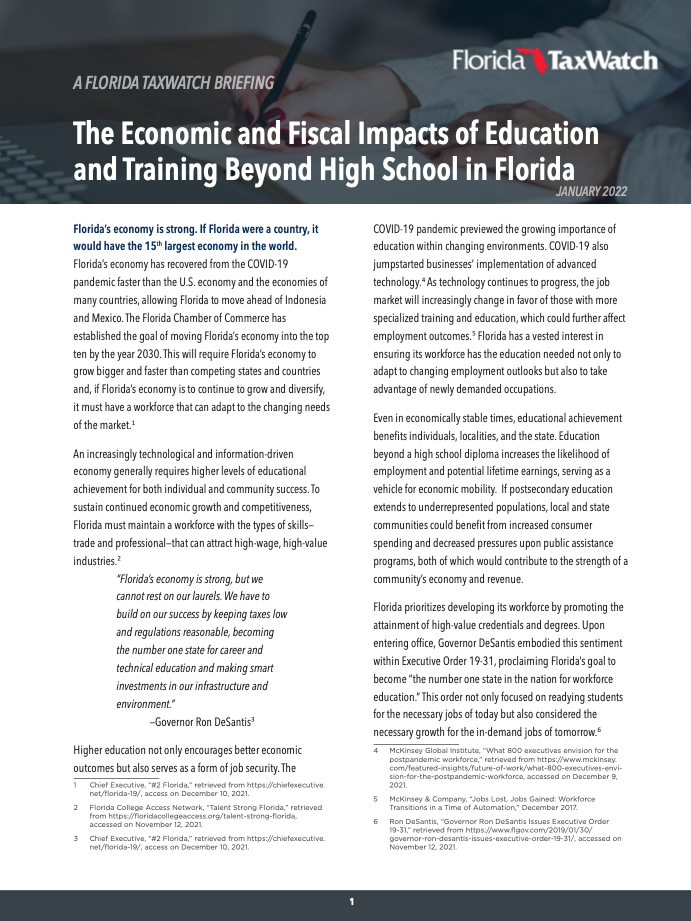The Economic and Fiscal Impacts of Education and Training Beyond High School in Florida

Florida’s economy is strong. If Florida were a country, it would have the 15th largest economy in the world. Florida’s economy has recovered from the COVID-19 pandemic faster than the U.S. economy and the economies of many countries, allowing Florida to move ahead of Indonesia and Mexico. The Florida Chamber of Commerce has established the goal of moving Florida’s economy into the top ten by the year 2030. This will require Florida’s economy to grow bigger and faster than competing states and countries and, if Florida’s economy is to continue to grow and diversify, it must have a workforce that can adapt to the changing needs of the market.
An increasingly technological and information-driven economy generally requires higher levels of educational achievement for both individual and community success. To sustain continued economic growth and competitiveness, Florida must maintain a workforce with the types of skills— trade and professional—that can attract high-wage, high-value industries.
“Florida’s economy is strong, but we cannot rest on our laurels. We have to build on our success by keeping taxes low and regulations reasonable, becoming the number one state for career and technical education, and making smart investments in our infrastructure and environment.”
—Governor Ron DeSantis
Higher education not only encourages better economic outcomes but also serves as a form of job security. The COVID-19 pandemic previewed the growing importance of education within changing environments. COVID-19 also jumpstarted businesses’ implementation of advanced technology. As technology continues to progress, the job market will increasingly change in favor of those with more specialized training and education, which could further affect employment outcomes. Florida has a vested interest in ensuring its workforce has the education needed not only to adapt to changing employment outlooks but also to take advantage of newly demanded occupations.
- FLORIDA STANDINGS - Florida’s goal is for 60 percent of working-age Floridians to have a high-value credential or degree by 2030. Data show 43 percent of working-age Floridians have an associate’s degree or higher and 34 percent have a high school degree or less. Different demographic groups are experiencing dissimilar rates of progress. Gender is another demographic to consider.
- ECONOMIC IMPACTS - As Florida overcomes the disruptions of the pandemic, it is entering a new economy with higher implementation of technology, and the influence of technology is only expected to increase in the years to come. Florida should bolster educational achievement to remain economically competitive within an increasingly specialized and technological job market. Both postsecondary credentials and degrees are valuable opportunities in this regard. More than half of the occupations projected to grow the fastest in Florida require a form of postsecondary education and the estimates suggest that these occupations have higher earning outcomes compared to fast growing occupations without education requirements.
- FISCAL IMPACTS - Florida could earn additional tax revenue and save on public assistance expenditures if educational achievement rose to be more comparable across the state.
As Florida navigates a world forever changed by COVID-19 and technology’s rising influence, stakeholders and policymakers should contemplate the advantages of increasing educational achievement across Florida’s diverse population. Enhanced education and training beyond high school not only helps individuals accumulate wealth and build self-sufficiency but it also fiscally and economically benefits communities and the state. As Florida aims toward higher rankings within the world economy, educational achievement can be a viable strategy for growth. An overarching goal is to reach the “Sail to 60” goal and move Florida’s economy into the world’s top ten. Achieving comparable educational achievement rates among all demographic groups is one way to get there.